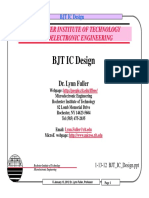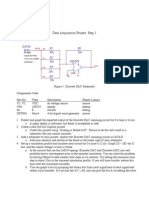Basic VLSI Slides
Basic VLSI Slides
Uploaded by
Divya AhujaCopyright:
Available Formats
Basic VLSI Slides
Basic VLSI Slides
Uploaded by
Divya AhujaOriginal Description:
Copyright
Available Formats
Share this document
Did you find this document useful?
Is this content inappropriate?
Copyright:
Available Formats
Basic VLSI Slides
Basic VLSI Slides
Uploaded by
Divya AhujaCopyright:
Available Formats
9/5/2015
VLSIDesign
ShailendraKumarTiwari
AssistantProfessor
(SeniorScale)
Lecture01
1. Reference Books
2. Syllabus.
3. What is there for me?
4. What is expected ?
5. Are we meeting with
expectation?
6. Device generations
7. Design abstraction level
8. Moores law
9. Technology generation
10.Conclusion
9/5/2015
ReferenceBooks
Basic VLSI Design, 3rd Ed., PHI
By: PUCKNELL DOUGLAS A.
KAMRAN ESHRAGHIAN,
9/5/2015
CMOS DIGITAL INTEGRATED
CIRCUITS:Analysis and Design
3rd Ed. McGraw-Hill.
By:SUNG-MO (STEVE) KANG
S.K.Tiwari(Asst.Prof.ECEMITManipal)
ReferenceBooks
CMOS LOGIC CIRCUIT DESIGN
Digital Integrated Circuits A Design
KLUWER ACADEMIC PUBLISHERS
Perspective,
By: John P. Uyemura
2nd ed. by J. Rabaey, A. Chandrakasan, B.
Nikolic
9/5/2015
S.K.Tiwari(Asst.Prof.ECEMITManipal)
4
9/5/2015
ReferenceBooks
CMOS VLSI Design:A Circuits and Systems
Perspective 4th ed. Addison-Wesley
By: Neil H. E. Weste, David Money Harris
9/5/2015
S.K.Tiwari(Asst.Prof.ECEMITManipal)
Syllabus
Course Plan
9/5/2015
Whatisthereforme?
http://www.pcb007.com/pages/zone.cgi?a=87231
Whatisthereforme?
http://www.pcb007.com/pages/zone.cgi?a=87231
9/5/2015
Whatisexpected?
1980s
1990s
2000s
Whatisexpected?
Complexity
Delay
Power
Cost
Min
Min
Min
Min
Design Time
Size
Min
9/5/2015
Arewemeetingwithexpectation?
W=0.7, L=0.7, Tox=0.7
Lateral and vertical
dimensions reduce 30 %
.
.
Area Cap = C =
0.7
.
Capacitance reduces by 30 %
0.7
Die Area =
0.7
0.5
Die area reduces by 50 %
Drain Current reduces by 30 %
Arewemeetingwithexpectation?
Delay
Delay reduces by 30 %
Power
P
power reduces by 50 %
9/5/2015
Arewemeetingwithexpectation?
Arewemeetingwithexpectation?
9/5/2015
Devicegenerations
Vacuum Tubes
BJT
FET
MOSFET
CMOS
Designabstractionlevel
9/5/2015
Mooreslaw
As predicted by Gordon Moore
in the 1960s, integrated circuit
(IC)
densities
have
been
doubling approximately every 18
months, and this doubling in size
has been accompanied by a
similar exponential increase in
circuit speed (or more precisely,
clock frequency)
January 3, 1929
TechnologyGeneration
Integrationlevel
Year
No.oftransistors
DRAMIntegration
SSI
1950s
Lessthan102
MSI
1960s
102 103
LSI
1970s
103 105
4K,16K,64K
VLSI
1980s
105 107
256K,1M,4M
ULSI
SLSI
1990s
2000s
107 109
Over109
16M,64M,256M
1G,4GandAbove
9/5/2015
MicroelectronicsTechnology
NMOS
MOS
Silicon
PMOS
CMOS
TTL
Active
Substrate
Bipolar
ECL
Micro
GaAs
Electronics
Inert
Substrate
VeryFast
Devices
Good
resistors
MOSVs.Bipolar
Factors
StaticPower
Dissipation
Input
Impedance
NoiseMargin
PackingDensity
Fanout
Direction
CMOS
Low
Bipolar
High
High
Low
High
High
Low
Bidirectional
Low
Low
High
Unidirectional
10
9/5/2015
DelayandPowerDissipationPerGate
MOSCapacitor
i. Accumulation
ii. Depletion
iii. inversion
11
9/5/2015
MOSCapacitor
NChannelMOSFET
Metal
Oxide
PSubstrate
PSubstrate
Metal
Oxide
Oxide
N+
PSubstrate
N+
PSubstrate
12
9/5/2015
NChannelMOSFET
Gate
Source
Drain
PChannelMOSFET
Metal
Oxide
NSubstrate
NSubstrate
Metal
Oxide
Oxide
P+
NSubstrate
P+
NSubstrate
13
9/5/2015
MOSFETSchematicSymbol
OperationOfNMOSTransistor
Depending on the relative voltages of the source,
drain and gate, the NMOS transistor may operate
in any of three regions viz :
Cut_off : Current flow is essentially zero (also
called accumulation region)
Linear : (Non saturated region)-It is weak
inversion region drain current depends on gate
and drain voltage.
Saturation : It is strong inversion region where
drain current is independent of drain-source
voltage.
14
9/5/2015
CutoffRegion
VGS=0
Source (S)
VDS=0
n+
n+
n+
n+
p-type substrate
(Body)
With zero gate bias (VGS=0) , no current flows between source
and drain, only the source to drain leakage current exists.
Current-voltage relation : IDS = 0
VGS < VT
LinearRegion
Formation of Depletion layer
Source (S)
0 VGS Vt
VDS=0
Depletion Layer
n+
n+
n+
n+
p-type substrate
(Body)
Small positive voltage applied to gate causes electric field to be
produced across the substrate
This in turn causes holes in P region to be repelled. This forms
the depletion layer under the gate.
15
9/5/2015
LinearRegion
Formation of Inversion layer :
Source (S)
VDS=0
VGS > Vt
Inversion Layer
n+
n+
n+
n+
p-type substrate
(Body)
the gate voltage is further increased, at particular voltage VT,
electrons are attracted to the region of substrate under gate thus forming
conduction path between source and drain.
This induced layer is called inversion layer. The gate voltage necessary
to form this layer is known as Threshold voltage (VT).
As application of electric field at gate causes formation of inversion
layer, the junction is known as field induced junction.
As
LinearRegion
Source (S)
VGS > Vt
VDS < VGS - Vt
Inversion Layer
n+
n+
n+
n+
p-type substrate
(Body)
When VDS is applied, the horizontal component of electric field (due
to source-drain voltage) and vertical component (due to gatesubstrate voltage) interact, causing conduction to occur along the
channel.
When effective gate voltage (VGS - VT) is greater than drain
voltage, current through the channel increases. This is non
saturated mode. ID = f (VGS,VDS)
16
9/5/2015
Saturation
Source (S)
VGS > Vt
n- channel
n+
n+
VDS = VGS - Vt
n+
n+
p-type substrate
(Body)
As VDS is increased, the induced Channel acquires a tapered shape and
its resistance increases with Increase in VDS.
Here VGS is kept constant at value > VT
Saturation
Source (S)
VGS > Vt
n- channel
n+
n+
VDS > VGS - Vt
n+
n+
p-type substrate
(Body)
When VDS > VGS VT, VGD < VT, the channel becomes pinched- off &
transistor is said to be in saturation.
Conduction is brought by drift mechanism of electrons under the
influence of positive drain voltage and effective channel length is
modulated.
17
9/5/2015
DepletionTypeMOS
D
Drain
Gate
Gate
Drain
Source
Source
NMOS
PMOS
NMOS
In Depletion MOS structure, the source & drain are diffused on
P- substrate as shown above.
Positive voltages enhances number of electrons from source to
drain.
Negative voltage applied to gate reduces the drain current
This is called as normally ON MOS.
DepletionTypeNMOS
Source (S)
Gate (G)
Drain (D)
Metal
Oxide (SiO2)
n+
n+
L
p-type substrate
(Body)
Body (B)
18
9/5/2015
DraintoSourceCurrentIDS
the gate and the channel region form a parallel plate
capacitor for which the oxide layer serves as a dielectric.
consider the infinitesimal strip of the gate at distance x
fromthe source. The capacitance of this strip is
CoxWdx
To find the charge stored on this infinitesimal strip of the
gate capacitance, we multiply the capacitance by the
effective voltage between the gate and the channel at
point x,
19
9/5/2015
Charge dq in the infinitesimal portion of the channel at
point x is
Negative sign accounts for the fact that dq is a negative
charge
The voltage VDS produces an electric field along the
channel in the negative x direction
The electric field E(x) causes the electron charge dq to
drift toward the drain with a velocity
Where n is the mobility of electrons in the channel (called
surface mobility).
The resulting drift current i
20
9/5/2015
Thus i must be equal to the source-to-drain current.
Since we are interested in the drain-to-source current iD,
we can find it as
Integrating both sides of this equation from x = 0 to x = L
and, correspondingly, for V(0) = 0 to V(L) = VDS,
21
9/5/2015
DraintoSourceCurrentIDS
Current is flow of charges.
IDS=f(VGS,VDS)
Continued ..
DraintoSourceCurrentIDS
Velocity v is given by
= electron or hole mobility (surface)
EDS= Drain to Source Electric Field
Continued ..
22
9/5/2015
DraintoSourceCurrentIDS
n = 650 cm2/V Sec
p = 240 cm2/V Sec
The Non-Saturated Region
Charge induced in channel due to VGS.
Voltage along the channel varies linearly with distance X
from source due to IR drop in the channel.
The average value of IR drop in the channel
2
Continued ..
DraintoSourceCurrentIDS
The effective gate voltage
VG= VGS-VT
Charge/unit area= EGins0
Charge induced in channel = WLEGins0
EG= Average electric field gate to channel.
0= 8.8510-14F/cm(Permittivity of free space)
ins= 04.0
2
D= Thickness of oxide layer
Continued ..
23
9/5/2015
DraintoSourceCurrentIDS
2
Continued ..
DraintoSourceCurrentIDS
Continued ..
24
9/5/2015
DraintoSourceCurrentIDS
SaturationRegion
DraincurveforNMOSoperatedwith
VGS>VT
25
9/5/2015
IDVDScharacteristics
IVcharacteristicsofNMOS
Transconductance curve
IGS = 0
+
-
9/5/2015
IS = ID
+
-
S.K.Tiwari(Asst.Prof.ECEMITManipal)
52
26
9/5/2015
Determine the Region of Operation of M1
1
Off because VGS=0V
Non-Saturation VGS Vt =(1-0.4)V=0.6V
VDS =0V; (VGS Vt)> VDS
4
Saturation VGS Vt =(1-0.4)V=0.6V
VDS =1.5V; (VGS Vt)< VDS
Non-Saturation VGS Vt =(1.5-.4)V=1.1V
VDS =0.5V; (VGS Vt)> VDS
Non-Saturation VGS Vt =(1.5-0.4)V=1.1V
VDS =0.5V; (VGS Vt)> VDS
Saturation VGS Vt =(0.5-0.4)V=0.1V
VDS =0.5V; (VGS Vt)< VDS
7
Cut-Off VGS =0V
Saturation VGS Vt =(1-0.4)V=0.6V
VDS =1V; (VGS Vt)< VDS
27
9/5/2015
A 0.18-m fabrication process is specified to have
tox= 4nm, n=450cm2/Vs and VT=0.5V. Find the
value of nCox(Also known as kn
process
transconductance) For a MOSFET with minimum
length fabricated in this process, find the required
value of W so that the device exhibits a channel
resistance rDS of 1K at VGS=1V. Device is operating
in deep linear region.
Kn= 388A/V2
W= 0.93m
Consider a process technology for which Lmin = 0.4 m,
tox = 8 nm, n = 450 cm2/V s, and Vt = 0.7 V.
(a) Find Cox and Kn.
Cox =4.31x10-3F/m2
Kn= 194.1 A/V2
(b) For a MOSFET with W/L= 8 m 0.8 m calculate the
values of VOV, VGS, and VDSmin needed to operate the
transistor in the saturation region with a dc current
ID = 100 A. VDSmin = VOV = 0.32 V VGS = 1.015 V
(c) For the device in (b), find the values of VOV and VGS
required to cause the device to operate as a 1000-resistor
for very small vD VOV = 0.51 V VGS = 1.215 V
28
9/5/2015
For a 0.8-m process technology for which tox = 15 nm and
n = 550 cm2/Vs, find Cox, Kn , and the overdrive voltage VOV
required to operate a transistor having W/L=20 in saturation
with ID = 0.2 mA. What is the minimum value of VDS needed?
Cox =2.301x10-3F/m2 Kn= 126.5A/V2 VDSmin = VOV = .397 V0.4V
A circuit designer intending to operate a MOSFET in
saturation is considering the effect of changing the device
dimensions and operating voltages on the drain current ID.
Specifically, by what factor does ID change in each of the
following cases?
(a) The channel length is doubled.
(b) The channel width is doubled.
(c) The overdrive voltage is doubled.
(d) The drain-to-source voltage is doubled.
An enhancement type NMOS transistor with Vt = 0.7V
has its source terminal grounded and a 1.5-V DC is
applied to the gate. In what region does the device
operate :for (a) VD = +0.5 V (b) VD = +0.9 V (c) VD = +3 V
If the NMOS device in nCox = 100 A/V2 , W = 10 m,
and L = 1 m, find the value of drain current that results
in each of the three cases (a), (b), and (c).
(a) Non Satn275 A
(b) Satn320 A
(c) Satn320 A
29
9/5/2015
The PMOS transistor shown in Fig. has Vtp=-1V,
(a) Find the range of VG for which the transistor conducts.
(b) In terms of VG, find the range of VD for which the transistor
operates in the triode region.
(c) In terms of VG, find the range of VD for which the transistor
operates in saturation.
SecondorderEffects
BodyEffect.
Subthresholdconduction
Channellengthmodulation
Mobilityvariation
FowlerNordheim tunneling
Drainpunchthrough
ImpactIonizationHotelectrons.
30
9/5/2015
BodyEffect
What happens if the bulk voltage of an N-MOSFET drops
below the source voltage ?
2
where MS is the difference between the
work functions of the polysilicon gate and
the silicon substrate
F= Fermi potential
Subthresholdconduction
For VGS VTH, a "weak inversion layer still exists and
some current flows from D to S. Even for VGS < VTH, ID is
finite, but it exhibits an exponential dependence on VGS
Called "subthreshold conduction. this effect can be
formulated for VDS greater than roughly 200 m V as
>1 is a nonideality factor
31
9/5/2015
Channellengthmodulation
is a process-technology parameter
with the dimensions of V-1
VA is a process-technology
dimensions of V.
parameter
with
the
32
9/5/2015
Mobilityvariation
Mobility is the defined as the ease with which the charge
carriers drift in the substrate material. Mobility decreases
with increase in doping concentration and increase in
temperature. Mobility is the ratio of average carrier drift
velocity and electric field. Mobility is represented by the
symbol .
FowlerNordhiem tunneling:
When the gate oxide is very thin there can be a current
between gate and source or drain by electron tunneling
through the gate oxide. This current is proportional to the
area of the gate of the transistor.
33
9/5/2015
Drainpunchthrough
When the drain is a high voltage, the depletion region
around the drain may extend to the source, causing the
current to flow even it gate voltage is zero. This is known
as Punchthrough condition.
ImpactIonizationHotelectrons
When the length of the transistor is reduced, the electric field
at the drain increases. The field can be come so high that
electrons are imparted with enough energy we can term them
as hot. These hot electrons impact the drain, dislodging holes
that are then swept toward the negatively charged substrate
and appear as a substrate current. This effect is known as
Impact Ionization.
34
9/5/2015
PassTransistors(NMOS)
NMOS
NMOSPasstransistorpassesstronglogic0.
NMOSPasstransistorpassesweaklogic1.
35
9/5/2015
PassTransistors(PMOS)
PassTransistors(PMOS)
36
9/5/2015
PMOS
PMOSPasstransistorpassesweaklogic0.
PMOSPasstransistorpassesstronglogic1.
TransmissionGate
PMOS Pass transistor passes strong logic 1.
NMOS Pass transistor passes strong logic 0.
37
9/5/2015
Inverters
Inverters
38
9/5/2015
Inverters
VOH:
VOL:
VIL:
VIH:
Maximum output voltage when the output level is logic " 1
Minimum output voltage when the output level is logic 0
Maximum input voltage which can be interpreted as logic "0"
Minimum input voltage which can be interpreted as logic "1"
ResistiveLoadInverter
39
9/5/2015
EnhancementloadNMOSinverter
DepletionLoadNMOSInverter
40
9/5/2015
DepletionLoadNMOSInverter
9/5/2015
S.K.Tiwari(Asst.Prof.ECEMITManipal)
81
DepletionLoadNMOSInverter
Calculation of VOH
When the input voltage Vin is smaller than the driver
threshold voltage VT0, the driver transistor is turned off
and does not conduct any drain current. Consequently,
the load device, which operates in the linear region, also
has zero drain current.
Substituting VOH for Vout
41
9/5/2015
DepletionLoadNMOSInverter
Calculation of VOL
We assume that the input voltage Vin of the inverter is equal to VOH = VDD
Driver transistor linear region
Depletion-type load saturation region
This second-order equation in VOL can be solved by temporarily
neglecting the dependence of VT load on VOL, as follows.
DepletionLoadNMOSInverter
Calculation of VIL
42
9/5/2015
DepletionLoadNMOSInverter
Calculation of VIL
DepletionLoadNMOSInverter
Calculation of VIH
43
9/5/2015
DepletionLoadNMOSInverter
Calculation of VIH
Where
44
9/5/2015
CMOSInverter
VOH: Maximum output voltage when the output level is logic " 1"
VOL : Minimum output voltage when the output level is logic "0"
VIL: Maximum input voltage which can be interpreted as logic "0"
VIH: Minimum input voltage which can be interpreted as logic " 1"
45
9/5/2015
RegionA
PMOS Nonsaturation Region
NMOS Cutoff
Vout= VDD - IDRCPMOS
Vout= VDD
RegionBVIL
PMOS Nonsaturation Region
NMOS Saturation Region
The slope of the VTC is equal to
(-1), when the input voltage is V =
VIL.
46
9/5/2015
To satisfy the derivative condition at VIL we differentiate
both sides with respect to Vin.
Where
RegionCVth
PMOS Saturation Region
NMOS Saturation Region
47
9/5/2015
Where
RegionDVIH
PMOS Saturation Region
NMOS Non-saturation Region
48
9/5/2015
Where
RegionEVOL
when the input voltage exceeds VDD the pMOS transistor
is turned off. In this case, the nMOS transistor is
operating in the linear region, but its drain to- source
voltage is equal to zero because
The output voltage of the circuit
is
49
9/5/2015
MOSTransistorTransconductance gm
andoutputconductancegds
MOSTransistorTransconductance gm
andoutputconductancegds
50
9/5/2015
MOSTransistorTransconductance gm
andoutputconductancegds
MOSTransistorFigureofMerit
51
9/5/2015
Determination of pullup to pulldown ratio (Zp.U/
Zp.D.) For An Nmos Inverter Driven By Another Nmos
Inverter
Vinv=0.5VDD
Note
52
9/5/2015
substitute typical values as follows
53
9/5/2015
PulluptopulldownratioforanNmos inverterdriven
throughoneormorepasstransistors
Vtp = threshold voltage for a pass transistor
Now, for depletion mode p.u. in saturation with VGS = 0
Note
54
9/5/2015
Consider inverter 2 (Figure 2.10(b)) when input = VDD- Vtp.
This image cannot currently be display ed.
This image cannot currently be display ed.
This image cannot currently be display ed.
55
9/5/2015
Taking typical values
0.5
56
9/5/2015
Mask
Common material used for masks are Photoresist, Polysilicon,
Silicon dioxide, Silicon nitride.
To create mask:
(a) deposit mask material over entire surface
(b) cut windows in the mask to create exposed areas
(c) deposit dopant
(d) remove un-required mask material
Masks plays important role in process called selective
diffusions.
The selective diffusion involves
1. Patterning windows in a mask material on the surface of
the wafer.
2. Subjecting the exposed areas to a dopant source.
3. Removing any un-required mask material.
9/5/2015
S.K.Tiwari(Asst.Prof.ECEMITManipal)
113
Photolithography
The Process of using an optical image and a photosensitive
film to produce a pattern on a substrate is photolithography
Photolithography depends on a photosensitive film called a
photo-resist.
Types of resist
Positive resist, a resist that become soluble when exposed
and forms a positive image of the plate.
Negative resist, a resist that lose solubility when
illuminated forms a negative image of the plate.
57
9/5/2015
Photolithography
ptype body
Substrate
9/5/2015
S.K.Tiwari(Asst.Prof.ECEMITManipal)
115
Photolithography
ptype body
9/5/2015
Resistapplication
S.K.Tiwari(Asst.Prof.ECEMITManipal)
116
58
9/5/2015
Photolithography
ptype body
9/5/2015
Exposure
S.K.Tiwari(Asst.Prof.ECEMITManipal)
117
Photolithography
Etching
ptype body
9/5/2015
PositiveResist
S.K.Tiwari(Asst.Prof.ECEMITManipal)
118
59
9/5/2015
Photolithography
Etching
ptype body
NegativeResist
9/5/2015
S.K.Tiwari(Asst.Prof.ECEMITManipal)
119
NMOS Fabrication Steps
1. Selection of Substrate
Si(100)
PType
2. Cleaning
3. Oxidation
SiO2
Si(100)
PType
Si+O2SiO2(good quality)
Si+2H2OSiO2+ 2H2(poor quality)
9/5/2015
S.K.Tiwari(Asst.Prof.ECEMITManipal)
120
60
9/5/2015
4.Lithography with MASK1
UV
+VEPhotoresist
SiO2
Si(100)
PType
A
MASK1
9/5/2015
S.K.Tiwari(Asst.Prof.ECEMITManipal)
121
Photoresist development and Oxide Etching
Si(100)
PType
Photoresist Etching
Si(100)
PType
9/5/2015
S.K.Tiwari(Asst.Prof.ECEMITManipal)
122
61
9/5/2015
Gate Oxidation
Si(100)
PType
Poly Silicon Deposition
Si(100)
PType
SiH4Si+2H2
9/5/2015
S.K.Tiwari(Asst.Prof.ECEMITManipal)
123
UV
Lithography for Gate Electrode
+VEPhotoresist
PolySi
Si(100)
PType
MASK2
9/5/2015
S.K.Tiwari(Asst.Prof.ECEMITManipal)
124
62
9/5/2015
Poly Patterning
Si(100)
PType
Photoresist Cleaning
Si(100)
PType
9/5/2015
S.K.Tiwari(Asst.Prof.ECEMITManipal)
125
Lithography for Source and Drain region
UV
Si(100)
PType
D
MASK3
9/5/2015
S.K.Tiwari(Asst.Prof.ECEMITManipal)
126
63
9/5/2015
Oxide etching (HF Cleaning)
Si(100)
PType
Photoresist cleaning
Si(100)
PType
9/5/2015
S.K.Tiwari(Asst.Prof.ECEMITManipal)
127
5,17,21,28,30,34,43,44,51,54,55,58,
Ion Implantation
N+
Si(100)
PType
N+
Thick Oxide Deposition
N+
9/5/2015
Si(100)
PType
N+
S.K.Tiwari(Asst.Prof.ECEMITManipal)
128
64
9/5/2015
Lithography and Contact Opening
UV
N+
Si(100)
PType
N+
D
MASK4
9/5/2015
S.K.Tiwari(Asst.Prof.ECEMITManipal)
Metallization and Patterning
S
N+
Si(100)
PType
129
N+
Body terminal is not shown..
9/5/2015
S.K.Tiwari(Asst.Prof.ECEMITManipal)
130
65
9/5/2015
FabricationofCMOSDevices
Technologies used for CMOS fabrications include
N-well process
P-well process
Twin-tub process
Silicon on insulator.
9/5/2015
S.K.Tiwari(Asst.Prof.ECEMITManipal)
131
PWellsandNWells
In order to have both types of transistors on the same substrate, the
substrate is divided into well regions (Shaded region in the
standard cells)
Two types of wells are available - n- well and p- well
In a p- substrate, an n- well is used to create a local region of n type
substrate, wherein the designer can create p- transistors
In a n- substrate, a p- well creates a local p- type substrate region, to
accommodate the n- transistors.
Hence, every p- device is surrounded by an n- well, that must be
connected to VDD via a VDD substrate contact.
Similarly, n- devices are surrounded by p- well connected to GND
using a GND substrate contact.
9/5/2015
S.K.Tiwari(Asst.Prof.ECEMITManipal)
132
66
9/5/2015
PWellsandNWells
IN
P substrate
contact [P+]
n+
OUT
D
n+
P-well
N substrate
contact [n+]
S
p+
G
p+
N-well
A p- transistor is built on an n- substrate and an n- transistor is
built on a p-substrate
9/5/2015
S.K.Tiwari(Asst.Prof.ECEMITManipal)
133
MASKforCMOSInverter
9/5/2015
S.K.Tiwari(Asst.Prof.ECEMITManipal)
134
67
9/5/2015
NWellCMOSInverter
1
SubstrateSelectionSi(100)
10
Lithography(MASK2)
CleaningoftheSubstrate
11
PolySiPatterning
Oxidation(1m)
12
Lithography(MASK3)
Lithography(MASK1)
13
HF(Oxide)Cleaning&PREtching
HF(Oxide)Cleaning&PREtching
14
Ionimplantation NMOS
NWellimplantation
15
Repeat12to14forPMOS
OxideEtching
16
DepositionofThickOxide
GateOxideDeposition
17
LithographyandOxidePatterning
PolySiDeposition
18
MetallizationandPatterning
9/5/2015
S.K.Tiwari(Asst.Prof.ECEMITManipal)
135
1.SelectionofSubstrate
Si(100)
Ptype
The n-well CMOS process starts with a moderately
doped (with impurity concentration typically less than
1015 cm-3)
P-type silicon substrate.
2.CleaningofSubstrate
9/5/2015
S.K.Tiwari(Asst.Prof.ECEMITManipal)
136
68
9/5/2015
3.Oxidation(1m)
SiO2
Si(100)
P type
9/5/2015
S.K.Tiwari(Asst.Prof.ECEMITManipal)
137
Lithography(MASK1)
UV
MASK1
PositivePhotoresist
SiO2
Si(100)
P type
9/5/2015
S.K.Tiwari(Asst.Prof.ECEMITManipal)
138
69
9/5/2015
HF(Oxide) Cleaning & PR Etching
SiO2
Si(100)
P type
SiO2
Si(100)
P type
9/5/2015
S.K.Tiwari(Asst.Prof.ECEMITManipal)
139
HF(Oxide) Cleaning & PR Etching
SiO2
Si(100)
P type
N-Well Implantation
N-type impurity implantation
SiO2
Si(100)
P type
9/5/2015
NWell
S.K.Tiwari(Asst.Prof.ECEMITManipal)
140
70
9/5/2015
OxideCleaning
Si(100)
P type
NWell
GateOxidation
Si(100)
P type
9/5/2015
NWell
S.K.Tiwari(Asst.Prof.ECEMITManipal)
141
PolySiliconDeposition
Si(100)
P type
9/5/2015
NWell
S.K.Tiwari(Asst.Prof.ECEMITManipal)
142
71
9/5/2015
Lithography(MASK2)
Si(100)
P type
9/5/2015
Si(100)
P type
Si(100)
P type
9/5/2015
NWell
S.K.Tiwari(Asst.Prof.ECEMITManipal)
143
NWell
NWell
S.K.Tiwari(Asst.Prof.ECEMITManipal)
144
72
9/5/2015
Lithography(MASK3)
Si(100)
P type
9/5/2015
NWell
S.K.Tiwari(Asst.Prof.ECEMITManipal)
145
HF(Oxide)Cleaning&PREtching
Remove the PR
Si(100)
P type
Si(100)
P type
9/5/2015
NWell
NWell
S.K.Tiwari(Asst.Prof.ECEMITManipal)
146
73
9/5/2015
IonImplantation
N+
N+
N+
NWell
Si(100)
P type
9/5/2015
S.K.Tiwari(Asst.Prof.ECEMITManipal)
147
Repeat12to14forPMOS
P+
N+
Si(100)
P type
9/5/2015
N+
P+
P+
N+
NWell
S.K.Tiwari(Asst.Prof.ECEMITManipal)
148
74
9/5/2015
ThickOxideDeposition
P+
N+
N+
P+
P+
N+
NWell
Si(100)
P type
9/5/2015
S.K.Tiwari(Asst.Prof.ECEMITManipal)
149
LithographyandOxidePatterning
P+
N+
Si(100)
P type
9/5/2015
N+
P+
P+
N+
NWell
S.K.Tiwari(Asst.Prof.ECEMITManipal)
150
75
9/5/2015
MetallizationandPatterning
VDD
VSS
P+
N+
Si(100)
P type
9/5/2015
N+
P+
P+
N+
NWell
S.K.Tiwari(Asst.Prof.ECEMITManipal)
151
TwinTubCMOSFabrication
9/5/2015
S.K.Tiwari(Asst.Prof.ECEMITManipal)
152
76
9/5/2015
1.SelectionofSubstrate
Si(100)
Ntype
The twin-tub CMOS process starts with a high resistive
n-type (100) silicon substrate.
2.CleaningofSubstrate
9/5/2015
S.K.Tiwari(Asst.Prof.ECEMITManipal)
153
EpitaxialLayerDeposition
Epitaxiallayer
Si(100)
Ntype
9/5/2015
S.K.Tiwari(Asst.Prof.ECEMITManipal)
154
77
9/5/2015
3.Oxidation(1m)
SiO2
Epitaxiallayer
Si(100)
Ntype
9/5/2015
S.K.Tiwari(Asst.Prof.ECEMITManipal)
155
Lithography(MASK1)
UV
MASK1
PositivePhotoresist
SiO2
Si(100)
Ntype
90
9/5/2015
S.K.Tiwari(Asst.Prof.ECEMITManipal)
156
78
9/5/2015
HF(Oxide) Cleaning & PR Etching
SiO2
Si(100)
Ntype
90
9/5/2015
S.K.Tiwari(Asst.Prof.ECEMITManipal)
157
SiO2
Si(100)
Ntype
9/5/2015
S.K.Tiwari(Asst.Prof.ECEMITManipal)
158
79
9/5/2015
HF(Oxide) Cleaning & PR Etching
SiO2
Si(100)
P type
Si(100)
Ntype
90
9/5/2015
S.K.Tiwari(Asst.Prof.ECEMITManipal)
N-Well Implantation
159
N-type impurity implantation
SiO2
NWell
Si(100)
Ntype
9/5/2015
S.K.Tiwari(Asst.Prof.ECEMITManipal)
160
80
9/5/2015
OxideCleaning
PWell
NWell
Si(100)
Ntype
GateOxidation
PWell
NWell
Si(100)
Ntype
9/5/2015
S.K.Tiwari(Asst.Prof.ECEMITManipal)
161
PolySiliconDeposition
PWell
NWell
Si(100)
Ntype
9/5/2015
S.K.Tiwari(Asst.Prof.ECEMITManipal)
162
81
9/5/2015
Lithography(MASK2)
PWell
NWell
Si(100)
Ntype
9/5/2015
S.K.Tiwari(Asst.Prof.ECEMITManipal)
PWell
163
NWell
Si(100)
Ntype
PWell
NWell
Si(100)
Ntype
9/5/2015
S.K.Tiwari(Asst.Prof.ECEMITManipal)
164
82
9/5/2015
Lithography(MASK3)
PWell
NWell
Si(100)
Ntype
9/5/2015
PWell
S.K.Tiwari(Asst.Prof.ECEMITManipal)
165
NWell
Si(100)
Ntype
9/5/2015
S.K.Tiwari(Asst.Prof.ECEMITManipal)
90
166
83
9/5/2015
IonImplantation
N+
N+
N+
NWell
PWell
Si(100)
Ntype
9/5/2015
S.K.Tiwari(Asst.Prof.ECEMITManipal)
P+
PWell
N+
N+
P+
167
P+
N+
NWell
Si(100)
Ntype
9/5/2015
S.K.Tiwari(Asst.Prof.ECEMITManipal)
168
84
9/5/2015
ThickOxideDeposition
P+
N+
N+
P+
P+
N+
NWell
PWell
Si(100)
Ntype
9/5/2015
S.K.Tiwari(Asst.Prof.ECEMITManipal)
169
LithographyandOxidePatterning
P+
PWell
N+
N+
P+
P+
N+
NWell
Si(100)
Ntype
9/5/2015
S.K.Tiwari(Asst.Prof.ECEMITManipal)
170
85
9/5/2015
MetallizationandPatterning
VDD
VSS
+
PP+
PWell
N++
N++
P+
P+
N+
NWell
Si(100)
Ntype
9/5/2015
S.K.Tiwari(Asst.Prof.ECEMITManipal)
171
LatchUp
Tendency of CMOS chips to
develop low-resistance paths
between VDD and VSS Called
Latch-up
9/5/2015
S.K.Tiwari(Asst.Prof.ECEMITManipal)
172
86
9/5/2015
LatchUp
These BJTs form a silicon-controlled
rectifier (SCR) with positive feedback
and virtually short circuit the power rail
to-ground, thus causing excessive
current flows and even permanent
device damage.
PNP transistor whose base is formed
by the n-well with its base-to-collector
current gain (1) as high as several
hundreds.
NPN transistor with its base formed by
the p-type substrate. The base-tocollector current gain 2 of this lateral
transistor may range from a few tenths
to tens
9/5/2015
S.K.Tiwari(Asst.Prof.ECEMITManipal)
173
Latchup
Rwell represents the parasitic resistance in the n-well
structure with its value ranging from 1 k to 20 k.
Rsub can be as high as several hundred ohms.
Unless the SCR is triggered by an external disturbance,
the collector currents of both transistors consist of the
reverse leakage currents of the collector-base junctions
and therefore, their current gains are very low.
If the collector current of one of the transistors is
temporarily increased by an external disturbance,
however, the resulting feedback loop causes this current
perturbation to be multiplied by (1 2). This event is called
the
triggering of the SCR.
9/5/2015
S.K.Tiwari(Asst.Prof.ECEMITManipal)
174
87
9/5/2015
Latchup
Once triggered, each transistor drives the other transistor with
positive feedback, eventually creating and sustaining a lowimpedance path between the power and the ground rails,
resulting in latch-up. It can be seen that if the condition
9/5/2015
S.K.Tiwari(Asst.Prof.ECEMITManipal)
175
TechniquetoovercomeLatchup
Use p+ guard-band rings connected to ground around
nMOS transistors and n+ guard rings connected to VDD
around pMOS transistors to reduce R and RSUb and to
capture injected minority carriers before they reach the
base of the parasitic BJTs.
Place substrate and well contacts as close as possible to
the source connections of MOS transistors to reduce the
values of Rwell and Rsub.
SOI Devices
9/5/2015
S.K.Tiwari(Asst.Prof.ECEMITManipal)
176
88
9/5/2015
SOIfabrication
Refer: Principles of CMOS VLSI Design A system perspective 2nd Ed. By Neil H. E. We
Kamran Eshraghian Page no. 125-129
9/5/2015
S.K.Tiwari(Asst.Prof.ECEMITManipal)
177
SOIfabrication
9/5/2015
S.K.Tiwari(Asst.Prof.ECEMITManipal)
178
89
9/5/2015
SOIfabrication
9/5/2015
S.K.Tiwari(Asst.Prof.ECEMITManipal)
179
SOIfabrication
9/5/2015
S.K.Tiwari(Asst.Prof.ECEMITManipal)
180
90
9/5/2015
SOIfabrication
9/5/2015
S.K.Tiwari(Asst.Prof.ECEMITManipal)
181
91
You might also like
- GLOBEDocument2 pagesGLOBEGrace100% (1)
- ESATAN 94 User GuideDocument560 pagesESATAN 94 User Guideknulp74No ratings yet
- Tetra Sans PS - Glassware / Tubecad - by John BroskieDocument17 pagesTetra Sans PS - Glassware / Tubecad - by John BroskieRafael Frederico TeixeiraNo ratings yet
- Agilent Eesof Eda: Presentation On Rfic Mos Gilbert Cell Mixer DesignDocument46 pagesAgilent Eesof Eda: Presentation On Rfic Mos Gilbert Cell Mixer DesignAniki4289No ratings yet
- All UNIX COMMANDSDocument658 pagesAll UNIX COMMANDSsuman100% (4)
- FAA Aircraft Wiring PracticesDocument61 pagesFAA Aircraft Wiring PracticesJorge Marquina100% (6)
- DOST-ASTI Electric Manual PDFDocument17 pagesDOST-ASTI Electric Manual PDFJB NavarroNo ratings yet
- Advanced Current Mirrors and Opamps: Hossein ShamsiDocument45 pagesAdvanced Current Mirrors and Opamps: Hossein ShamsiChristian Montano GalvezNo ratings yet
- BJT IC Design: Rochester Institute of Technology Microelectronic EngineeringDocument41 pagesBJT IC Design: Rochester Institute of Technology Microelectronic EngineeringPauloConstantinoNo ratings yet
- Analysis of Opamp Using PspiceDocument19 pagesAnalysis of Opamp Using PspiceKarThiNo ratings yet
- Cmos LayoutDocument13 pagesCmos LayoutshastryNo ratings yet
- Transistor Active High Pass Filter Electronics NotesDocument2 pagesTransistor Active High Pass Filter Electronics NotesRenato DeákNo ratings yet
- Aic Lec 12 5t Ota v01Document37 pagesAic Lec 12 5t Ota v01Mustafa NasserNo ratings yet
- Final Report On Op-Amp To OTA ConversionDocument41 pagesFinal Report On Op-Amp To OTA ConversionAman VatsNo ratings yet
- Lecture 6 - 7 Power - AmplifiersDocument77 pagesLecture 6 - 7 Power - AmplifierssunilsheelavantNo ratings yet
- 1308 - 12297 A New Class-D Stereo Audio Amplifier Using Direct Speaker Current ControlDocument3 pages1308 - 12297 A New Class-D Stereo Audio Amplifier Using Direct Speaker Current Controlrodales56No ratings yet
- Sar AdcDocument13 pagesSar AdcHunZilah ShEikhNo ratings yet
- Vented. Box Loudspeaker Systems Part I1: Large-Signal AnalysisDocument7 pagesVented. Box Loudspeaker Systems Part I1: Large-Signal AnalysisEclys MontenegroNo ratings yet
- Ecen 607 CMFB-2011Document44 pagesEcen 607 CMFB-2011Girish K NathNo ratings yet
- Chapter SixDocument5 pagesChapter Sixyunus memonNo ratings yet
- The Jordan Loudspeaker Manual Chapter 6Document5 pagesThe Jordan Loudspeaker Manual Chapter 6Adam PaulNo ratings yet
- Yamaha Rx-V3067 Rx-A3010 SCHDocument89 pagesYamaha Rx-V3067 Rx-A3010 SCHCleber MouraNo ratings yet
- ADCsurvey LatestDocument112 pagesADCsurvey LatestsairaghubabuNo ratings yet
- Pro Co Rat AnalysisDocument16 pagesPro Co Rat AnalysisgianmarcoNo ratings yet
- Low Phase Noise VCO Design Thesis PDFDocument133 pagesLow Phase Noise VCO Design Thesis PDFAhmed KamalNo ratings yet
- Lec1 Single Stage AmpDocument29 pagesLec1 Single Stage AmpA8719No ratings yet
- C3.0 Operational Amplifiers II: Jeng-Han TsaiDocument12 pagesC3.0 Operational Amplifiers II: Jeng-Han Tsailinux14No ratings yet
- Phase Locked Loop & Voltage Controlled Oscillator: by Professor, Dept. of ECE, MITDocument20 pagesPhase Locked Loop & Voltage Controlled Oscillator: by Professor, Dept. of ECE, MITCHANDU PRAKASHNo ratings yet
- 10 GyratorDocument14 pages10 GyratorPako AlbNo ratings yet
- Band GapDocument16 pagesBand GapmchernitskyNo ratings yet
- Tda 2005 DatasheetDocument25 pagesTda 2005 DatasheetRuben NinaNo ratings yet
- Chapter 17Document66 pagesChapter 17helenarajNo ratings yet
- Amplifier Frequecny ResponseDocument63 pagesAmplifier Frequecny ResponseNuman khanNo ratings yet
- Design and Analysis of Low Power Bandgap Voltage ReferenceDocument8 pagesDesign and Analysis of Low Power Bandgap Voltage ReferencePraveen Kumar ReddyNo ratings yet
- Design ProjectDocument19 pagesDesign Projectcard2717No ratings yet
- Unit 2 Large Signal AmplifiersDocument56 pagesUnit 2 Large Signal AmplifiersGovindan VedhanayagamNo ratings yet
- Vlsi Lab 1Document11 pagesVlsi Lab 1Shawon karmokar JotyNo ratings yet
- Wireless FM Microphone CircuitDocument2 pagesWireless FM Microphone Circuitcuongspvl2713No ratings yet
- BJT Diff AmplifierDocument15 pagesBJT Diff AmplifierAdrià Amézaga Sàrries100% (1)
- HotFET Pre J-FET Audio Preamplifier SchematicsDocument6 pagesHotFET Pre J-FET Audio Preamplifier SchematicsJefri ErlanggaNo ratings yet
- Design Procedure For Fully Differential Folded Cascode OTADocument4 pagesDesign Procedure For Fully Differential Folded Cascode OTAwleaderheeNo ratings yet
- BJT As An Amplifier: Biasing and Small Signal Model: ECE60L Lecture Notes, Spring 2002Document15 pagesBJT As An Amplifier: Biasing and Small Signal Model: ECE60L Lecture Notes, Spring 2002anon020202100% (1)
- Transistor BC107 Practical Common EmitteDocument9 pagesTransistor BC107 Practical Common EmittevjvjlogNo ratings yet
- Non-Inverting Operational Amplifier ConfigurationDocument10 pagesNon-Inverting Operational Amplifier ConfigurationMirHaiderAliShaurov100% (1)
- ADC DAC DiscreteDocument4 pagesADC DAC Discretegersonymayer100% (1)
- Chapter 7. Switched-Inductor Regulators With Design Insight and Intuition (Power IC Design)Document119 pagesChapter 7. Switched-Inductor Regulators With Design Insight and Intuition (Power IC Design)Minh Hai RungNo ratings yet
- Integrated CircuitsDocument24 pagesIntegrated CircuitsmuktikantaNo ratings yet
- Chapter 09Document87 pagesChapter 09anujNo ratings yet
- Class D Tutorial 2Document74 pagesClass D Tutorial 2Gerardo Mendez CamarilloNo ratings yet
- Design and Implementation of High Gain, High Bandwidth CMOS Folded Cascode Operational Transconductance AmplifierDocument5 pagesDesign and Implementation of High Gain, High Bandwidth CMOS Folded Cascode Operational Transconductance AmplifierChristian Montano GalvezNo ratings yet
- Design of 4 Watt Power AmplifierDocument3 pagesDesign of 4 Watt Power AmplifierTapas Sarkar100% (1)
- Astable MultivibratorDocument146 pagesAstable Multivibratorsantovaron123No ratings yet
- Opamp DesignDocument60 pagesOpamp DesignSiva KumarNo ratings yet
- Data Converter FundamentalsDocument27 pagesData Converter FundamentalstkbattulaNo ratings yet
- LC MeterDocument8 pagesLC Meterrokib2048No ratings yet
- Lecture17 Fully Diff Amps CMFBDocument28 pagesLecture17 Fully Diff Amps CMFBmohamedNo ratings yet
- Rail To Rail Amplifier ProjectDocument19 pagesRail To Rail Amplifier Projectneva91No ratings yet
- TI TX LinesDocument10 pagesTI TX LinesSantosh Kumar PatraNo ratings yet
- Microwave Filters for Communication Systems: Fundamentals, Design, and ApplicationsFrom EverandMicrowave Filters for Communication Systems: Fundamentals, Design, and ApplicationsNo ratings yet
- WCDMA: Requirements and Practical DesignFrom EverandWCDMA: Requirements and Practical DesignRudolf TannerNo ratings yet
- Transmission Lines in Digital Systems for EMC PractitionersFrom EverandTransmission Lines in Digital Systems for EMC PractitionersNo ratings yet
- Metal Oxide Semiconductor TransistorsDocument39 pagesMetal Oxide Semiconductor TransistorsK MukundNo ratings yet
- AbcdDocument1 pageAbcdDivya AhujaNo ratings yet
- Smart Kunci Kira-Kira Bookstore Pada 31 Mac 2015Document2 pagesSmart Kunci Kira-Kira Bookstore Pada 31 Mac 2015Divya AhujaNo ratings yet
- Man and His Salvation in The GospelsDocument5 pagesMan and His Salvation in The GospelsDivya AhujaNo ratings yet
- Software License Online Tools and Documents, Inc. ("OLT") Doing Business As: The 9000 Store, AS9100 StoreDocument2 pagesSoftware License Online Tools and Documents, Inc. ("OLT") Doing Business As: The 9000 Store, AS9100 StoreDivya AhujaNo ratings yet
- Ghy Uzzéyh° Ãâíjé BGW JT¡F Gÿë, Iy NKL, Nry - 6 C©Ik J Ik M¿A GL Nt©Oa RH ¿Jœ Égu - 10 X ¿A : Nry Ef®ÒwDocument2 pagesGhy Uzzéyh° Ãâíjé BGW JT¡F Gÿë, Iy NKL, Nry - 6 C©Ik J Ik M¿A GL Nt©Oa RH ¿Jœ Égu - 10 X ¿A : Nry Ef®ÒwDivya AhujaNo ratings yet
- 1371893623330-Steel and Aluminium Works PDFDocument68 pages1371893623330-Steel and Aluminium Works PDFDivya AhujaNo ratings yet
- Test Bank For Operations and Supply Chain Management, Binder Ready VersionDocument38 pagesTest Bank For Operations and Supply Chain Management, Binder Ready VersionDivya AhujaNo ratings yet
- Gat Percentage ArrivingDocument1 pageGat Percentage ArrivingDivya AhujaNo ratings yet
- Opportunities in FsaeDocument2 pagesOpportunities in FsaeDivya AhujaNo ratings yet
- Class22 - SAP UI5 - ABAP - GateWay - Fiori Note File Attachment PDFDocument4 pagesClass22 - SAP UI5 - ABAP - GateWay - Fiori Note File Attachment PDFDivya AhujaNo ratings yet
- Ayush - Resume 2Document2 pagesAyush - Resume 2ayushpatnaik7No ratings yet
- 320D ServiceDocument47 pages320D Servicestefendy100% (14)
- WV Wood ByproductsDocument33 pagesWV Wood ByproductsJoe HowardNo ratings yet
- Practical Database DesignDocument13 pagesPractical Database DesignDarrell100% (6)
- Excel Multi Level BOM Template and ExampleDocument20 pagesExcel Multi Level BOM Template and ExamplePacoNo ratings yet
- 20220422N RPU80 - 160 - 300 ManualDocument38 pages20220422N RPU80 - 160 - 300 Manualccarralero1No ratings yet
- TR-3702 NetApp Storage Best Practices Virtualization and NetApp Snap Manager For Hyper-VDocument106 pagesTR-3702 NetApp Storage Best Practices Virtualization and NetApp Snap Manager For Hyper-Vfly4phunNo ratings yet
- Electronic Unit Injector - Adjust: Pruebas y AjustesDocument4 pagesElectronic Unit Injector - Adjust: Pruebas y Ajustesluismf14No ratings yet
- Dimension Tables: Speed Reducer CHH - 613 DA To 618 DADocument1 pageDimension Tables: Speed Reducer CHH - 613 DA To 618 DAsalpa nugrahaNo ratings yet
- Civil-DCI - INDEXDocument3 pagesCivil-DCI - INDEXAnonymous 2Dz4Kq9M7No ratings yet
- Saudades de Minha TerraDocument72 pagesSaudades de Minha TerraSamuel WelysonNo ratings yet
- Superwool HT Z-Blok ModulesDocument3 pagesSuperwool HT Z-Blok Modulesมิตร อันมาNo ratings yet
- Maintenance TrainingDocument22 pagesMaintenance TrainingMark Jayson PasaoaNo ratings yet
- MM Project ProposalDocument4 pagesMM Project ProposalSikander AzamNo ratings yet
- Starting ChargingDocument4 pagesStarting ChargingRicardo JuarezNo ratings yet
- PRO6000 ServiceManualDocument8 pagesPRO6000 ServiceManualAms HydNo ratings yet
- General Energy EquationDocument9 pagesGeneral Energy EquationdervoooNo ratings yet
- Dok TD Bu1 AceDocument8 pagesDok TD Bu1 AceIkhsan IslahNo ratings yet
- EONMUD 310 M2 (Rev 10) PDFDocument6 pagesEONMUD 310 M2 (Rev 10) PDFekoNo ratings yet
- More:: Sales ReportDocument8 pagesMore:: Sales ReportShifu RaulNo ratings yet
- Tigerclaw Installation Instructions For TCG Tc120Document2 pagesTigerclaw Installation Instructions For TCG Tc120jim6116No ratings yet
- 07-Turbine Operation-U4Document315 pages07-Turbine Operation-U4karthick.gNo ratings yet
- Telephone DirectoryDocument2 pagesTelephone DirectoryHaseeb AnwarNo ratings yet
- Lenar Format LessonDocument2 pagesLenar Format Lessonapi-318297366100% (1)
- CBLM CHS NC2 Terminating and Connect of Electrical Wiring and Electronic CircuitsDocument20 pagesCBLM CHS NC2 Terminating and Connect of Electrical Wiring and Electronic CircuitsEleunamme Zx67% (9)
- Plumbing EstimateDocument6 pagesPlumbing EstimateLester CabungcalNo ratings yet



































































































